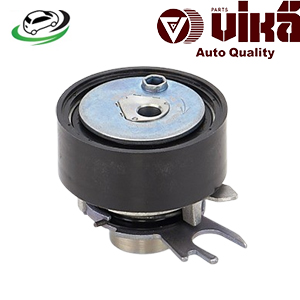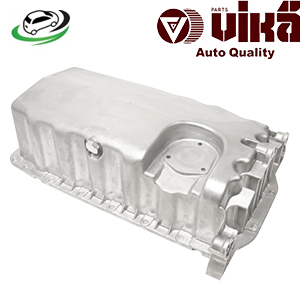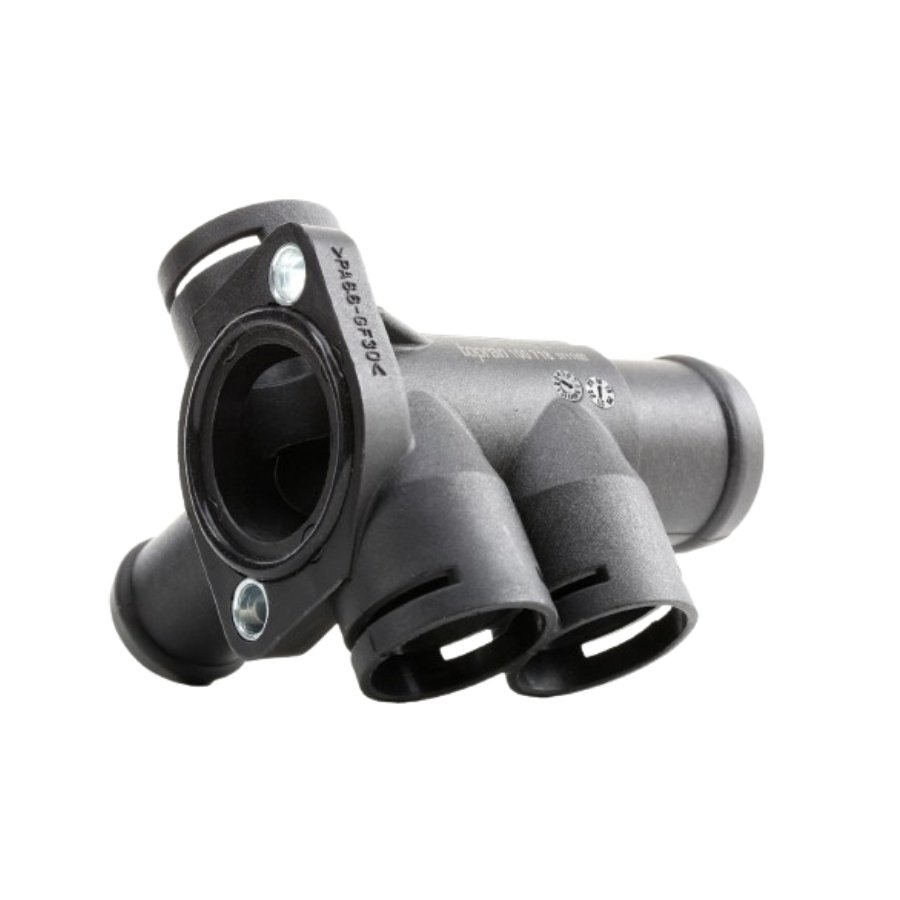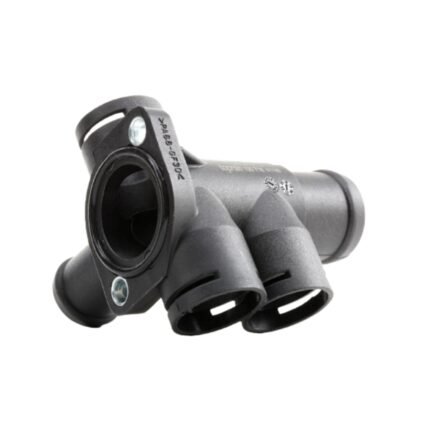Get VW Corrado G60 Diesel Coolant Flange 037121132B in Kenya
A coolant flange is a connector, usually made of plastic, metal, or composite material, that helps distribute coolant from the engine to the radiator and other components in the cooling system. It’s often bolted to the engine block or cylinder head and provides attachment points for coolant hoses, sensors, and other fittings.
The primary purpose of the coolant flange is to allow engine coolant to flow through various paths, directing it to different parts of the engine to manage the heat generated during combustion. By doing this, it plays a key role in maintaining the engine’s operating temperature within the safe range.
2. How Does a Coolant Flange Work?
The coolant flange connects to the engine block or cylinder head and acts as a hub for coolant hoses. Coolant flows from the engine through the flange, where it is then directed to different parts of the cooling system, such as:
- Radiator: The coolant absorbs heat from the engine and carries it to the radiator, where it is dissipated into the atmosphere.
- Thermostat Housing: Coolant flanges often integrate the thermostat housing, where the thermostat regulates the engine’s operating temperature by controlling the flow of coolant.
- Heater Core: The flange also directs coolant to the heater core inside the vehicle’s cabin for climate control purposes.
The coolant flange is designed with multiple ports to accommodate various connections, including hoses and sensors, to regulate coolant flow. It plays a pivotal role in ensuring that the coolant circulates efficiently and maintains the optimal engine temperature.
3. Functions of a Coolant Flange
Coolant flanges perform several key functions in the engine’s cooling system, ensuring both the engine and the cabin climate control function smoothly. Here are the primary functions:
- Coolant Distribution: The coolant flange directs the flow of coolant between the engine, radiator, thermostat, and heater core. This is essential for controlling engine temperatures and preventing overheating.
- Connection Point for Coolant Hoses: The flange acts as a junction for various hoses in the cooling system, allowing for efficient coolant distribution.
- Housing for Sensors: Many coolant flanges are equipped with ports for sensors like the temperature sensor, which monitors the engine’s coolant temperature and sends signals to the ECU (engine control unit).
- Thermostat Housing Integration: In some vehicles, the thermostat is housed within the coolant flange, controlling when the coolant flows to the radiator based on engine temperature.
- Sealing Coolant Flow: The flange also serves as a seal between the engine block or cylinder head and the hoses, preventing coolant leaks at connection points.
4. Types of Coolant Flanges
Coolant flanges vary based on the material used, their design, and the vehicle model. Below are the most common types:
1. Plastic Coolant Flanges
- Materials: These are often made from durable, heat-resistant plastic or composite materials.
- Advantages: Lightweight and cost-effective.
- Disadvantages: Prone to wear, cracking, or warping due to exposure to high temperatures over time.
2. Metal Coolant Flanges
- Materials: Usually made from aluminum or steel.
- Advantages: Highly durable and resistant to cracking under extreme temperature changes.
- Disadvantages: Heavier than plastic and potentially more expensive.
3. Integrated Coolant Flanges
- Design: Some coolant flanges come with integrated sensors or thermostats, making them a more complex part of the cooling system.
- Advantages: Combines multiple components into one unit for easier installation.
- Disadvantages: If any part fails (e.g., thermostat or sensor), the entire unit might need to be replaced.
5. Benefits of a Properly Functioning Coolant Flange
A well-maintained coolant flange provides numerous benefits:
- Prevents Engine Overheating: By directing coolant flow to essential components, the flange helps regulate engine temperature, preventing overheating, which can cause significant damage like warped cylinder heads or engine seizure.
- Ensures Efficient Coolant Flow: With a properly functioning flange, coolant circulates efficiently through the system, leading to better temperature control and improved engine performance.
- Seals Coolant Pathways: The flange helps create a sealed environment where coolant can flow without leakage, reducing the risk of coolant loss or contamination.
- Supports Sensors and Thermostats: The coolant flange often houses temperature sensors and thermostats, which are crucial for monitoring and controlling the engine’s temperature.
- Improves Cabin Heating: A good coolant flange ensures proper coolant flow to the heater core, which translates to better heating performance in the vehicle’s cabin.
6. Common Issues with Coolant Flanges
Coolant flanges can face several issues, especially as the vehicle ages. Some of the most common problems include:
- Coolant Leaks: Over time, the seals around the flange can degrade, or the flange itself may crack, leading to coolant leaks. A loss of coolant can result in engine overheating and poor heater performance.
- Cracks and Warping: Plastic coolant flanges are particularly prone to cracking or warping after prolonged exposure to engine heat. This compromises their ability to maintain a proper seal.
- Corrosion: Metal flanges, though more durable than plastic, can corrode over time, especially if the coolant mixture isn’t maintained correctly. Corrosion weakens the metal, leading to leaks.
- Failed Sensors or Thermostats: In flanges that integrate sensors or thermostats, a failure in these components can lead to inaccurate temperature readings or improper coolant flow regulation. This can result in engine overheating or poor performance.
7. Symptoms of a Faulty Coolant Flange
Some key symptoms of a malfunctioning coolant flange include:
- Coolant Leaks: The most common sign is coolant leaking from the area where the flange connects to the engine or hoses. You might notice a puddle of coolant under the vehicle or visible dripping from the flange.
- Engine Overheating: A faulty flange can disrupt coolant flow, leading to engine overheating. Overheating may manifest as an increase in engine temperature or an illuminated temperature warning light on the dashboard.
- Low Coolant Levels: If the flange is leaking, you may notice the coolant reservoir level dropping more quickly than usual.
- Poor Cabin Heating: If coolant isn’t flowing correctly to the heater core, the vehicle’s cabin heating may become weak or fail to work entirely.
- Check Engine Light: A malfunctioning temperature sensor or thermostat housed in the coolant flange may trigger the check engine light.
8. Maintenance and Replacement of Coolant Flange
Regular maintenance of the cooling system, including the coolant flange, is essential for the long-term health of your engine. Here are a few key maintenance tips:
- Coolant Flange Inspection: Regularly inspect the coolant flange for signs of wear, cracks, or leaks, especially if the vehicle is older. Look for any visible damage or coolant accumulation around the flange area.
- Coolant System Checks: Periodically check the entire cooling system, including the coolant level, hoses, and clamps. Proper coolant system pressure helps prevent unnecessary strain on the flange.
- Coolant Replacement: Ensure that the engine coolant is replaced according to the vehicle manufacturer’s recommendations. Using the correct coolant mixture can prevent corrosion and reduce the likelihood of leaks or damage to the flange.
- Replace When Necessary: If you notice a cracked or leaking flange, it’s important to replace it promptly to prevent engine overheating. When replacing the flange, always use the correct OEM or high-quality aftermarket part to ensure proper fit and function.
Conclusion
A coolant flange is a crucial yet often overlooked part of the vehicle’s cooling system. It ensures proper distribution of coolant throughout the engine and radiator, helping to maintain optimal engine temperature and performance. Regular inspection and maintenance of the coolant flange are key to preventing leaks, overheating, and costly engine damage. Whether made from plastic or metal, the coolant flange requires careful attention, especially as the vehicle ages, to ensure long-term engine reliability and efficiency.
Follow us on Facebook for more parts.





Reviews
Clear filtersThere are no reviews yet.